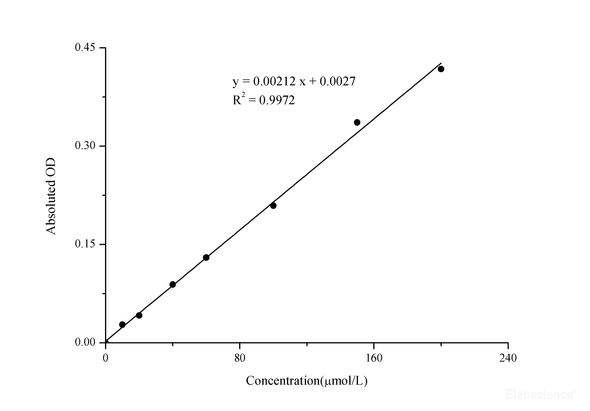Feiyuebio
MDA(Malondialdehyde) ELISA Kit
- SKU:
- FY-EU4065
- Weight:
- 0 KGS
- Shipping:
- Calculated at Checkout
Description
MDA(Malondialdehyde) ELISA Kit Basic Information
|
Product Name |
MDA(Malondialdehyde) ELISA Kit |
|
Catalog NO. |
FY-EU4065 |
|
Alias |
MDA ELISA Kit, Malondialdehyde ELISA Kit |
|
Application |
MDA ELISA Kit allows for the in vitro quantitative determination of MDA concentrations in serum, plasma, tissue homogenates and other biological fluids. |
|
Size |
48T, 96T |
|
Storage |
2-8 ℃ for 6 months |
|
Sensitivity |
<4.688ng/ml |
|
Species |
Universal |
|
CV %() |
Intra-Assay: CV<8% |
|
Note |
For Research Use Only |
Feiyue’s MDA is an ELISA reagent for detection of MDA in human serum, plasma or cell with sensitivity, specificity and consistency.
MDA(Malondialdehyde) Introduciton
MDA is a substituted methylenedioxylated phenethylamine and amphetamine derivative. In relation to other phenethylamines and amphetamines, it is the 3,4-methylenedioxy, α-methyl derivative of β-phenylethylamine, the 3,4-methylenedioxy derivative of amphetamine, and the N-desmethyl derivative of MDMA. MDA may be quantitated in blood, plasma or urine to monitor for use, confirm a diagnosis of poisoning or assist in the forensic investigation of a traffic or other criminal violation or a sudden death. Some drug abuse screening programs rely on hair, saliva, or sweat as specimens. Most commercial amphetamine immunoassay screening tests cross-react significantly with MDA and major metabolites of MDMA, but chromatographic techniques can easily distinguish and separately measure each of these substances. The concentrations of MDA in the blood or urine of a person who has taken only MDMA are, in general, less than 10% those of the parent drug.
MDA(Malondialdehyde) ELISA Kit Test method
This kit was based on Competitive-ELISA detection method.
The microtiter plate provided in this kit has been pre-coated with target. During the reaction, target in the sample or standard competes with a fixed amount of target on the solid phase supporter for sites on the Biotinylated Detection Antibody specific to target. Excess conjugate and unbound sample or standard are washed from the plate, and HRP-Streptavidin (SABC) is added to each microplate well and incubated. Then TMB substrate solution is added to each well. The enzyme -substrate reaction is terminated by the addition of a sulphuric acid solution and the color change is measured spectrophotometrically at a wavelength of 450nm. The concentration of target in the samples is then determined by comparing the OD of the samples to the standard curve.
Reference:
- Crean, R. D.; Davis, S. A.; Von Huben, S. N.; Lay, C. C.; Katner, S. N.; Taffe, M. A. (13 October 2006). "Effects of (±)3,4-methylenedioxymethamphetamine, (±)3,4-methylenedioxyamphetamine and methamphetamine on temperature and activity in rhesus macaques". Neuroscience. 142 (2): 515–525. doi:10.1016/j.neuroscience.2006.06.033. PMC 1853374. PMID 16876329.
- de la Torre, R; Farre, M; Roset, Pn; Pizzaro, N; Abanades, S; Segura, M; Segura, M; Camí, J (2004). "Human pharmacology of MDMA: pharmacokinetics, metabolism, and disposition". Therapeutic Drug Monitoring. 26 (2): 137–144. doi:10.1097/00007691-200404000-00009. PMID 15228154.
- EcstasyData.org. "EcstasyData.org: Test Result Statistics: Substances by Year". www.ecstasydata.org. Retrieved 27 June 2017.
- "Trans European Drug Information". idpc.net. Retrieved 27 June 2017.
Additional Information
Size: |
96T |
Reactivity: |
Universal |
Assay range: |
7.813-500ng/ml |
sensitivity: |
4.688ng/ml |









